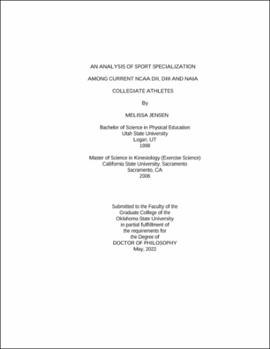| dc.contributor.advisor | Dawes, J. Jay | |
| dc.contributor.author | Jensen, Melissa | |
| dc.date.accessioned | 2023-03-16T21:14:22Z | |
| dc.date.available | 2023-03-16T21:14:22Z | |
| dc.date.issued | 2022-05 | |
| dc.identifier.uri | https://hdl.handle.net/11244/337127 | |
| dc.description.abstract | Sport specialization (SS) is when youth athletes train in one sport for at least eight months a year, excluding all other sports. Early sport specialization (ESS) is specialization at or younger than twelve years. Negative consequences of ESS are both physiological and psychological. Athletes specialize because of the enjoyment of that sport more than others; the desire to improve skill, compete beyond high school, and earn a college athletic scholarship; and pressure from coaches and parents. Few studies have investigated the frequency of SS of collegiate athletes. The primary purpose of this study was to determine the differences in the mean age of competitive sport initiation and SS in current collegiate athletes between school classification (DII, DIII, NAIA), sex, type of sport (team- vs. individual-based), and size of high school. A secondary purpose was to identify the reasons athletes decide to specialize. An online survey was provided via an email sent to the athletes’ coach. Current rosters from sanctioned NCAA and NAIA sports were included. A total of 1610 completed surveys were analyzed. Two three-way mixed factorial ANOVAs, and four one-way ANOVAs were used. The mean age of competitive sport initiation was 7.89 ± 3.10 yrs. There was a difference between males and females (p < 0.001) and the type of sport (p < 0.001). There was an interaction effect of sex and school classification (p = 0.008) and school classification and type of sport (p = 0.006). Sixty-three percent of the athletes indicated they specialized with a mean age of 14.33 ± 2.27 yrs. There was a difference between males’ and females’ mean age of SS (p = 0.012). There was no difference between school classification, type of sport, or any interaction effects. Athletes from large high schools specialized earlier than those from small-sized high schools (p < 0.001). The three most common reasons to specialize were enjoyment of the sport, desire to improve, and desire to compete beyond high school. These findings suggest it may not be necessary to specialize in one sport at an early age to compete beyond high school. | |
| dc.format | application/pdf | |
| dc.language | en_US | |
| dc.rights | Copyright is held by the author who has granted the Oklahoma State University Library the non-exclusive right to share this material in its institutional repository. Contact Digital Library Services at lib-dls@okstate.edu or 405-744-9161 for the permission policy on the use, reproduction or distribution of this material. | |
| dc.title | Analysis of sport specialization among current NCAA DII, DIII and NAIA collegiate athletes | |
| dc.contributor.committeeMember | Trevino, Michael | |
| dc.contributor.committeeMember | Dinyer-McNeely, Taylor | |
| dc.contributor.committeeMember | Gardner, Brandt | |
| osu.filename | Jensen_okstate_0664D_17557.pdf | |
| osu.accesstype | Open Access | |
| dc.type.genre | Dissertation | |
| dc.type.material | Text | |
| dc.subject.keywords | athletes | |
| dc.subject.keywords | college | |
| dc.subject.keywords | sport specialization | |
| thesis.degree.discipline | Health, Leisure and Human Performance | |
| thesis.degree.grantor | Oklahoma State University | |
